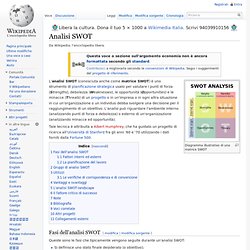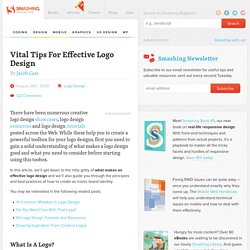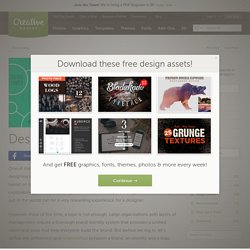

Course Introduction (14:11) Analisi SWOT. Da Wikipedia, l'enciclopedia libera.

Diagramma illustrativo di una matrice SWOT L'analisi SWOT (conosciuta anche come matrice SWOT) è uno strumento di pianificazione strategica usato per valutare i punti di forza (Strengths), debolezza (Weaknesses), le opportunità (Opportunities) e le minacce (Threats) di un progetto o in un'impresa o in ogni altra situazione in cui un'organizzazione o un individuo debba svolgere una decisione per il raggiungimento di un obiettivo. L'analisi può riguardare l'ambiente interno (analizzando punti di forza e debolezza) o esterno di un'organizzazione (analizzando minacce ed opportunità). Tale tecnica è attribuita a Albert Humphrey, che ha guidato un progetto di ricerca all'Università di Stanford fra gli anni '60 e '70 utilizzando i dati forniti dalla Fortune 500. Fasi dell'analisi SWOT[modifica | modifica sorgente] Queste sono le fasi che tipicamente vengono seguite durante un'analisi SWOT: Come possiamo utilizzare e sfruttare ogni forza?
Hill, T. & R. SWOT analysis. A SWOT analysis, with its four elements in a 2×2 matrix.

A SWOT analysis (alternatively SWOT matrix) is a structured planning method used to evaluate the strengths, weaknesses, opportunities and threats involved in a project or in a business venture. A SWOT analysis can be carried out for a product, place, industry or person. It involves specifying the objective of the business venture or project and identifying the internal and external factors that are favorable and unfavorable to achieve that objective. Some authors credit SWOT to Albert Humphrey, who led a convention at the Stanford Research Institute (now SRI International) in the 1960s and 1970s using data from Fortune 500 companies.[1][2] However, Humphrey himself does not claim the creation of SWOT, and the origins remain obscure. The degree to which the internal environment of the firm matches with the external environment is expressed by the concept of strategic fit. Matching and converting[edit] Use[edit] Strategy building[edit]
Vital Tips For Effective Logo Design. There have been numerous creative logo design showcases1, logo design resources2 and logo design tutorials3 posted across the Web.

While these help you to create a powerful toolbox for your logo designs, first you need to gain a solid understanding of what makes a logo design good and what you need to consider before starting using this toobox. In this article, we’ll get down to the nitty gritty of what makes an effective logo design and we’ll also guide you through the principles and best practices of how to create an iconic brand identity. You may be interested in the following related posts: What Is A Logo? To understand what a logo is, we first must understand what the main purpose of logos is. Paul Rand, one of the world’s greatest designers states that “a logo is a flag, a signature, an escutcheon, a street sign.
For more on Paul Rand, consider reading the book Design, Form & Chaos8. What Makes A Good Logo? Logo Design Process Image by Panoramas12. Designing a Brand Identity. One of the most interesting projects that a graphic designer can take on is designing a logo.

It can be daunting (and stressful) to come up with logo options based on market research, and stumble upon some "design magic" through the exploratory process. Narrowing it down to a final approved logo and then seeing it out in the world can be a very rewarding experience for a designer. However, most of the time, a logo is not enough. Large organizations with layers of management require a thorough brand identity system that provides a unified vision and tools that help everyone build the brand. But before we dig in, let's define the difference (and relationship) between a brand, an identity and a logo.
Brand vs. A Brand (or Branding) refers to the perceived image and subsequent emotional response to a company, its products and services. Phase 1: Research, Vision & Design Brief This phase should be as thorough as needed — depending on the depth of research and size of the company. 1.